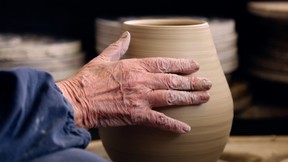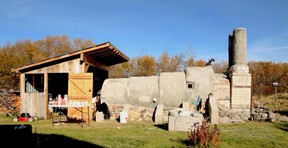Article content
Peace Country residents will have the opportunity to view ceramics created by a local artist trained in the art of Japanese ceramics in a new art exhibit opening this month at Beaverlodge.
Article content
The exhibit, called “High Fire,” can be seen at the Beaverlodge Arts and Culture Center from October 31 to November 25, and is primarily a ceramic display created by artist Bibi Clement using a traditional Japanese Anagama kiln.
The exhibition will also feature pieces by Lane Borstad, a retired GPRC art history professor and friend of Clement.
“Bibi has been doing this for many years and she really is a master craftswoman, she is quite revered in larger communities,” Borstad said.
Clement has lived in the Peace Region since 1993 and has previously been a fashion designer, filmmaker, and clay artist in cities such as Algiers, Paris, and Vancouver.
Clement has been studying with Japanese ceramics teachers since 1997 and has gained a following in Canada and Japan.
“He studied in Japan, he has exhibited in Japan, he has taught in Japan and he has had Japanese master potters come to do workshops here in Hythe a few times,” Borstad said.

According to Borstad, this style of pottery originated in Korea and Japan and dates back hundreds of years. Ceramics are based on the Japanese concept of wabi-sabi that celebrates the idea of impermanence.
“The idea that change is the constant and the beauty of things lies in imperfection and lack of fullness, it is something humble and modest,” said Borstad.
According to Borstad, Clement was one of the first people in Western Canada to have a full-scale Anagama kiln, and his work is found in collections throughout Western Canada.
Article content
“Bibi’s aesthetic is about the artist producing a unique object and each one in its process is different,” said Borstad. “Even when you have a dinner set of hers, every plate, every cup, and every item on that [set] it has a uniqueness. “
The process is created by adding wood to the oven fire every 20-30 seconds, 24 hours a day, for three to five days.
The heat inside the kiln becomes so intense that the ash inside turns into glass that drips all over the ceramic.
“It’s not something you can have absolute control over,” Borstad said, adding that “that’s part of the Japanese aesthetic about nature, change and impermanence.”
Clement also injects salt into the kiln, which creates additional texture to the pottery, and according to Borstad, he is not aware of another potter in the north who uses this process.
“It creates this very special kind of beauty that you can’t get in a mechanical oven,” Borstad said.

Borstad met Clement 25 years ago when she was teaching student workshops at GPRC, but it was when she was retired that Borstad developed a friendship with Clement and decided to pursue pottery.
“I totally fell in love with his Anagama process,” Borstad said.
Borstad will also sell a special line of soup bowls that it created with all proceeds going to the Beaverlodge Food Bank.
Admission to the exhibition is free and the Beaverlodge Arts and Culture Center is open Tuesday through Sunday.
Reference-www.dailyheraldtribune.com